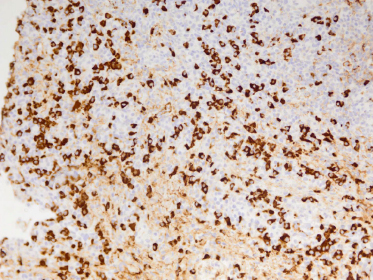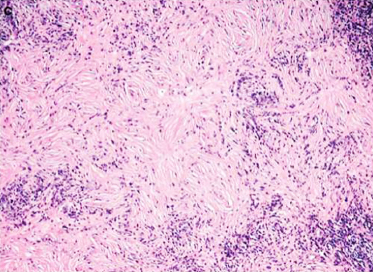IgG4-Related Disease
Emory University School of Medicine, Atlanta, GA, USA
Introduction
IgG4-related disease (IgG4-RD) is a systemic fibro-inflammatory condition formally recognized as an entity in the past decade. This condition is defined by its highly characteristic histopathology and immunostaining pattern that is similar across the organ systems involved. Regardless of the affected organ, these patients share unique clinical features including:
- tendency to form mass lesions;
- elevated serum IgG4 concentration (in the majority of patients);
- excellent response to glucocorticoid treatment.
This disease was first identified in the pancreas as “autoimmune pancreatitis” (AIP). In 2001, AIP was linked to elevated serum IgG4 concentrations, and shortly thereafter, to the presence of large numbers of IgG4-positive plasma cells in the pancreatic tissues. A variety of extrapancreatic lesions was observed to occur in patients with AIP that shared the same pathological features found in the pancreas. This observation led to the proposal of a new systemic condition now called IgG4-related disease (IgG4-RD).
Multiple organ involvement can occur simultaneously; it may also precede or develop years after the initial recognition of the index organ.
Although it is not clear if autoimmunity plays any role in the etiology of this condition, rheumatology is probably the most appropriate specialty to manage this disease for several reasons:
- it is an immune-mediated fibrosing condition;
- it mimics other systemic rheumatologic conditions;
- it responds well to steroid treatment.
Additionally, many known entities followed by rheumatologists are now recognized to be part of the IgG4-RD spectrum, including Mikulicz’s disease, retroperitoneal fibrosis, multifocal fibrosclerosis, lymphoplasmacytic aortitis, and inflammatory orbital pseudotumors.
Histology
- Two distinct features link separate manifestations of IgG4-RD in different organs and unify variable entities as one systemic condition
- A unique histopathologic appearance
- Abundance of IgG4+ plasma cells in the tissue (Figure 5.1)

Figure 5.1 Immunostaining for IgG4 in IgG4-RD. The majority of plasma cells appear positive for IgG4 (Color plate 5.1).
- A unique histopathologic appearance
- Modest eosinophilia in the tissue is also a common finding
- Fibrosis in IgG4-RD is mostly organized, at least focally, in a storiform pattern (Figure 5.2)

Figure 5.2 IgG4-related disease typically shows an irregularly whorled pattern of fibrosis (storiform fibrosis) associated with lymphoplasmacytic infiltration (Color plate 5.2).
- The storiform pattern resembles the spokes of a cartwheel with spindle cells radiating from the center
- Initially, increased number of IgG4+ plasma cells was the hallmark of the disease
- As knowledge with regard to this condition grew it was realized that the abundance of IgG4+ plasma cells in the absence of compatible specific histology could be found in a wide spectrum of diseases
- Abundance of IgG4+ plasma cells alone is not adequate as a distinguishing feature in IgG4-related disease
- As knowledge with regard to this condition grew it was realized that the abundance of IgG4+ plasma cells in the absence of compatible specific histology could be found in a wide spectrum of diseases
Epidemiology
- The overall epidemiology of IgG4-RD in the general population remains unknown
- This condition usually affects elderly men with a mean age between 58 and 69 years
- The male to female ratio is reported as 4:1, although studies of patients with only head and neck involvement of the disease show almost equal sex distributions
- IgG4-RD was initially recognized in Japan and most studies reported in the literature are from Japan
- Knowledge has spread to investigators and clinicians around the world, and it seems that the disease occurs in every geographic and ethnic population with no obvious preference
- Definitive assessment of its incidence and prevalence among all populations as a systemic disease requires multinational cohorts studying IgG4-RD, which are lacking at this point
- Knowledge has spread to investigators and clinicians around the world, and it seems that the disease occurs in every geographic and ethnic population with no obvious preference
Etiology
- The pathogenesis of IgG4-RD is poorly understood
- Based on serological, immunological, and molecular studies it is suggested that autoimmunity, allergy (hypersensitivity), or molecular mimicry may play roles in its mechanism of disease
- The IgG4 molecule is postulated to be a protective antibody with regard to allergens and certain infectious agents like parasites
- It typically appears after prolonged immunization, especially in the context of IgE-mediated allergy and immunotherapy, but its exact physiologic role is poorly understood
- In the past decades, our understanding about the role of IgG4 in different immune-mediated conditions has changed remarkably
- IgG4 antibodies against desmoglein 1 play a major role in blister formation in pemphigus vulgaris and foliaceus
- IgG4 antibodies against M-type phospholipase A2 receptor cause idiopathic memebranous glomerulonephritis
- Antibodies against the metalloproteinase ADAMTS13, which is the pathogenic antibody in thrombotic thrombocytopenic purpura, are IgG4 antibodies
- → For these reasons, this molecule is not just an immune-modulating and anti-inflammatory antibody
- At the same time, the IgG4 molecule is present in the involved tissues with chronic inflammation in certain conditions like rheumatoid arthritis, granulomatosis with polyangiitis, and sarcoidosis
- IgG4 antibodies against desmoglein 1 play a major role in blister formation in pemphigus vulgaris and foliaceus
- The role of IgG4 molecules in IgG4-RD is still uncertain
- No specific autoantigen has been identified, and it is not clear whether the IgG4 antibodies are a byproduct of certain types of inflammation or pathogenic themselves in this condition
- It typically appears after prolonged immunization, especially in the context of IgE-mediated allergy and immunotherapy, but its exact physiologic role is poorly understood
Clinical Manifestations
- The initial presentation of patients with IgG4-RD is often a mass that has developed subacutely in the affected organ, causing symptoms due to mass effect or damage to the organ
- Painless jaundice due to a mass or swelling in the head of the pancreas
- Pseudotumor of the orbit
- Pulmonary nodule resembling cancer

Stay updated, free articles. Join our Telegram channel
- Painless jaundice due to a mass or swelling in the head of the pancreas

Full access? Get Clinical Tree







